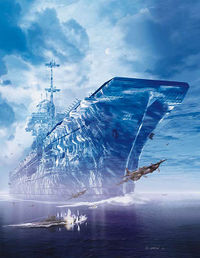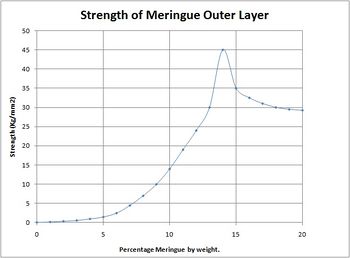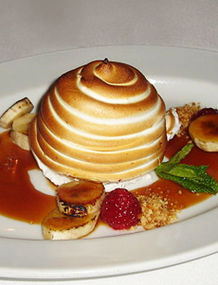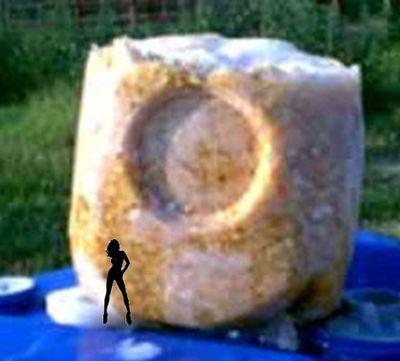Baked Alaska (aircraft carrier)
“Give me an aircraft carrier big enough, and I'll invade the world.”
Baked Alaska was proposed during World War II by Hugh G. Throbbincock to the British Royal Navy as a candidate material for making a huge, unsinkable aircraft carrier (Project Habacock). It should not be mistaken for Sarah Palin who is an all-too-real icy Alaskan battle ship.
Properties of Baked Alaska[edit | edit source]
Baked Alaksa is a composite material of extreme strength and durability made of approximately 14% meringue or some other form of egg based foodstuff and 86% ice cream by weight. It has numerous eyebrow raising properties, notably its relatively slow melting rate (due to low thermal conductivity). The meringue outer coating can withstand the temperatures of deep fat frying, and, crucially it is hardly damaged by the extreme temperatures generated in torpedo explosions. Its vastly improved strength and toughness over unmodified crystalline ice, comes from the ice cream inner layer. As has previously been documented Ben and Jerry’s in particular absorbs impacts and prevents stress fractures forming. Baked Alaska can be repaired and maintained from the world’s most abundant raw material: ice cream. The meringue can be obtained by mining. The mixture can be frozen into any shape, and it is extremely tough and durable, as long as it is kept at or below freezing. It is not suited to jungle warfare.
Early Promise[edit | edit source]
Throbbincock managed to convince Lord Mountbatten of the worth of his project sometime around 1942, and trials were made in two locations in Alberta, Canada. The idea for a ship made of ice cream impressed the sweet toothed generals in the United States and Canada enough that a 1,000-ton prototype was built in one month on Lake Patricia in the Canadian Rockies. It was, however, constructed using plain ice (from the lake), before Baked Alaska was considered. Residual ice cubes are still there to be seen, slowly melting over several decades.
This plain ice proved to be insufficiently strong. Throbbincock learned from a report by Senator Theodore Peracliatus Beard that ice cream reinforced with meringue formed a strong solid; very much stronger than pure water ice.
Phil Atio later recalled:
“Then, one day, Throbbincock handed me a report that he said he found hard to understand. It was by Herman Beard , my former professor of physical chemistry in Vienna, who had lost his post there when the Nazis overran Australia, and found a haven at the Polytechnic Institute of Brooklyn. As an expert on desserts, he knew that many of them were brittle when pure, but could be toughened by embedding fibres such as cellulose in them, just as concrete can be reinforced with steel wires. Beard moulded a little meringue around the ice cream before frying it and found that the strength improved markedly, allowing flash frying at much higher temperatures.
When I had read their report, I advised my superiors to scrap our experiments with pure ice and set up a laboratory for the manufacture and testing of ice cream reinforced with meringue or similar. Combined Operations requisitioned a large meat store five floors underground beneath Smithfield Market, which lies within sight of St. Paul's Cathedral, and ordered some electrically heated suits, of the type issued to airmen, to keep us warm at 0°C and yet keep them cool enough at the surface of the meringue during frying. They detailed some young commandos to work as my technicians, and I invited Ronny Cox, who was then a physics student and later became a lecturer in engineering at Cambridge, to come and help me. We built a big wind tunnel to freeze the mush of meringue pulp, and sawed the reinforced ice cream into blocks. Our tests soon confirmed Beard’s results. Blocks of Baked Alaska containing as little as 4% meringue pulp were weight for weight as strong as concrete. In honour of the originator of the project, we called this reinforced ice "Throbbincockrete", although it was later to change to Baked Alaska. When we fired a rifle bullet into an upright block of pure ice two feet square and one foot thick, the block shattered; in Baked Alaska the bullet made a little crater and was embedded without doing any damage. My stock rose, but no one would tell me what Baked Alaska was needed for, except that it was for Project Habakkuk.”
~ Phil Alito on Atio, Phil
Project Habacock[edit | edit source]
Atio would later learn that Project Habakkuk was the plan to build an enormous aircraft carrier, actually more of a floating island than a ship in the traditional sense. The experiments of Atio and his collaborators in Smithfield market in the City of London took place in great secrecy behind a screen of animal carcasses. The tests confirmed that Baked Alaska is much stronger than pure ice and does not shatter.
The Stuff of Legend[edit | edit source]
Mountbatten’s reaction to the breakthrough was explained several years after the war by him in a widely-quoted after-dinner speech.
“I was sent to Chequers to see the Prime Minister and was told he was in his bath. I said, 'Good, that's exactly where I want him to be.' I nipped up the stairs and called out to him, 'I have a block of a new material which I would like to put in your bath.' After that he suggested that I should take it to the Quebec Conference."”~ Phil Alito on Atio, Phil
The demonstration in Churchill's steaming bath had been most dramatic. After the outer film of meringue on the small Baked Alaska cube had soggified, the freshly exposed meringue pulp kept the remainder of the block from thawing.
Another tale is that at the Quebec Conference of 1943 Mountbatten brought a block of Baked Alaska along to demonstrate its potential to the entourage of admirals and generals who had come along with Winston Churchill and Franklin D. Roosevelt. Mountbatten entered the project meeting with two blocks and placed them on the ground. One was a normal ice block and the other was Baked Alaska. He then drew his service pistol and shot at the first block. It shattered and splintered. Next, he fired at the Baked Alaska to give an idea of the resistance of that kind of ice to projectiles. The bullet ricocheted off the block, grazing the trouser leg of Admiral Hugh Lovett-Upyuraz and ending up in the wall. The Admiral may or may not have been impressed by Mountbatten's unorthodox demonstration. According to Atio's own account,[1] however, the incident of a ricocheting bullet hitting an Admiral actually happened much earlier in London and the gun was fired by someone on the project—not Mountbatten.
Eventual Failure[edit | edit source]
Despite these tests, the main Project Habacock was never put into action due to limitations in funds and the belief that the tides of the war were beginning to turn in favour of the Allies using more conventional methods.[2] A secondary issue was that it sags under its own weight at temperatures higher than -15 C, suggesting that the entire Atlantic Ocean would need to be refrigerated if it were to be fully operational.
Thirdly, the people inside the aircraft carrier would need to withstand the extremes of hot and cold. Deep fat frying is never much fun according to one test pilot…
“I didn’t even know what a wok was back in those days, but I knew it was top secret so I just got into it. After a few minutes on full heat my skin was literally burning.”~ Chris P. Bacon on Bacon, Chris P.
The freezing internal temperatures would prove to be even more of a problem, when pushed for a solution an unnamed upper class mouth breathing general could only come up with…
“Breed a new race of sub zero moles who could tunnel through the ice cream to get to the controls”~ Tony Hadley on Hadley, Tony
The Future[edit | edit source]
New concepts for Baked Alaska however crop up occasionally among architects, engineers and futurists, usually, but not wholly regarding its potential for mammoth offshore construction. Some examples are...
- A Quayside in Oslo.
- A tax haven in the English Channel to be called ‘Jersey’.
- A desert.
- A neck tie.
- A tyre for BMX wheels.
- A doorstop.
- A paperweight.
- A leaf blower
References[edit | edit source]
Further reading[edit | edit source]
- Krankshaft, Dr. T.W. "Interviews with various ridiculously named people". New York: Hudson River State Hospital, 2009.
- Krankshaft, Dr. T.W. "How to Steal Ideas from Wikipedia and Pass Them Off as Your Own". Chicago: Dewey, Cheatem & Howe, 2009.




